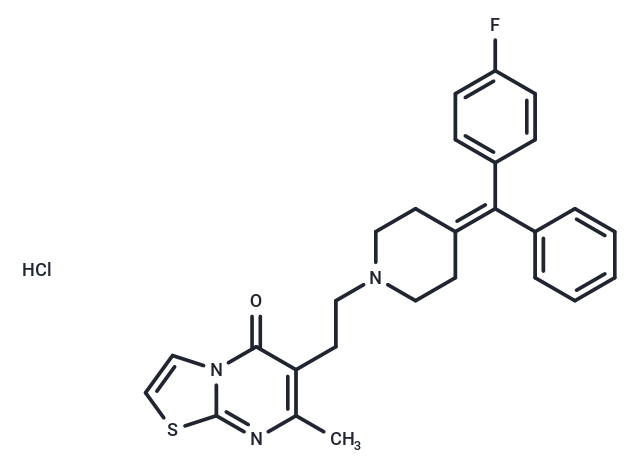Shopping Cart
Remove All Your shopping cart is currently empty
Your shopping cart is currently empty
R 59-022 hydrochloride (DKGI-I hydrochloride) is a 5-HT Receptor antagonist that activates protein kinase C (PKC).R 59-022 hydrochloride is a DGK inhibitor (IC50:2.8 µM) that inhibits the phosphorylation of OAG to OAPA.R 59-022 enhances thrombin-induced triglyceride production in platelets and inhibits the production of phosphatidic acid in neutrophils. R 59-022 enhances thrombin-induced diglyceride production in platelets and inhibits phosphatidic acid production in neutrophils.

| Pack Size | Price | USA Warehouse | Global Warehouse | Quantity |
|---|---|---|---|---|
| 2 mg | $32 | In Stock | In Stock | |
| 5 mg | $53 | In Stock | In Stock | |
| 10 mg | $88 | In Stock | In Stock | |
| 25 mg | $178 | In Stock | In Stock | |
| 50 mg | $287 | In Stock | In Stock | |
| 100 mg | $413 | - | In Stock |
| Description | R 59-022 hydrochloride (DKGI-I hydrochloride) is a 5-HT Receptor antagonist that activates protein kinase C (PKC).R 59-022 hydrochloride is a DGK inhibitor (IC50:2.8 µM) that inhibits the phosphorylation of OAG to OAPA.R 59-022 enhances thrombin-induced triglyceride production in platelets and inhibits the production of phosphatidic acid in neutrophils. R 59-022 enhances thrombin-induced diglyceride production in platelets and inhibits phosphatidic acid production in neutrophils. |
| Targets&IC50 | DGK:2.8 µM |
| In vitro | R 59-022 (10 μM; 1 min) Hydrochloride enhances platelet aggregation.[1] R 59-022 (30 μM; 0-60 min) Hydrochloride increases the release of norepinephrine in chromaffin cells.[2] R 59-022 (40 μM; 30 min) Hydrochloride activates PKC in HeLa and U87 cells.[3] R 59-022 (0-10 μM; 4 h) Hydrochloride blocks the entry of EBOV GP into Vero cells.[4] |
| In vivo | R 59-022 (2 mg/kg; i.p.; 12 days) significantly increased the median survival of SCID mice implanted with U87 GBM cells.[6] |
| Synonyms | DKGI-I hydrochloride ; Diacylglycerol kinase inhibitor I hydrochloride, DKGI-I hydrochloride, Diacylglycerol kinase inhibitor I hydrochloride |
| Molecular Weight | 496.04 |
| Formula | C27H27ClFN3OS |
| Cas No. | 93076-98-3 |
| Smiles | Cl.O=C1C(=C(N=C2SC=CN21)C)CCN3CCC(=C(C=4C=CC=CC4)C5=CC=C(F)C=C5)CC3 |
| Storage | Powder: -20°C for 3 years | In solvent: -80°C for 1 year | Shipping with blue ice/Shipping at ambient temperature. | |||||||||||||||||||||||||||||||||||
| Solubility Information | DMSO: 55 mg/mL (110.88 mM), Sonication is recommended. | |||||||||||||||||||||||||||||||||||
| In Vivo Formulation | 10% DMSO+40% PEG300+5% Tween 80+45% Saline: 2 mg/mL (4.03 mM), Sonication is recommended. Please add the solvents sequentially, clarifying the solution as much as possible before adding the next one. Dissolve by heating and/or sonication if necessary. Working solution is recommended to be prepared and used immediately. The formulation provided above is for reference purposes only. In vivo formulations may vary and should be modified based on specific experimental conditions. | |||||||||||||||||||||||||||||||||||
Solution Preparation Table | ||||||||||||||||||||||||||||||||||||
DMSO
| ||||||||||||||||||||||||||||||||||||
| Size | Quantity | Unit Price | Amount | Operation |
|---|

Copyright © 2015-2026 TargetMol Chemicals Inc. All Rights Reserved.